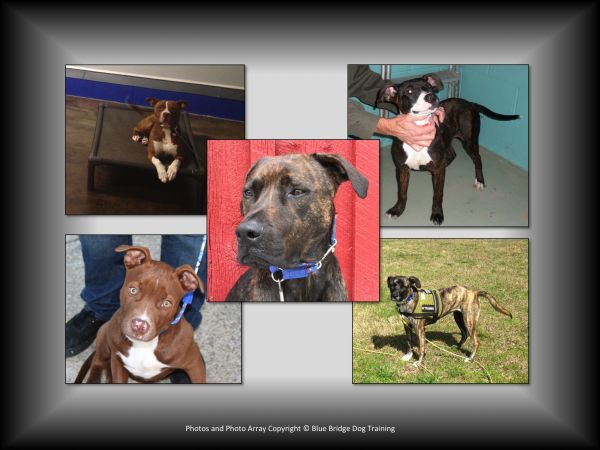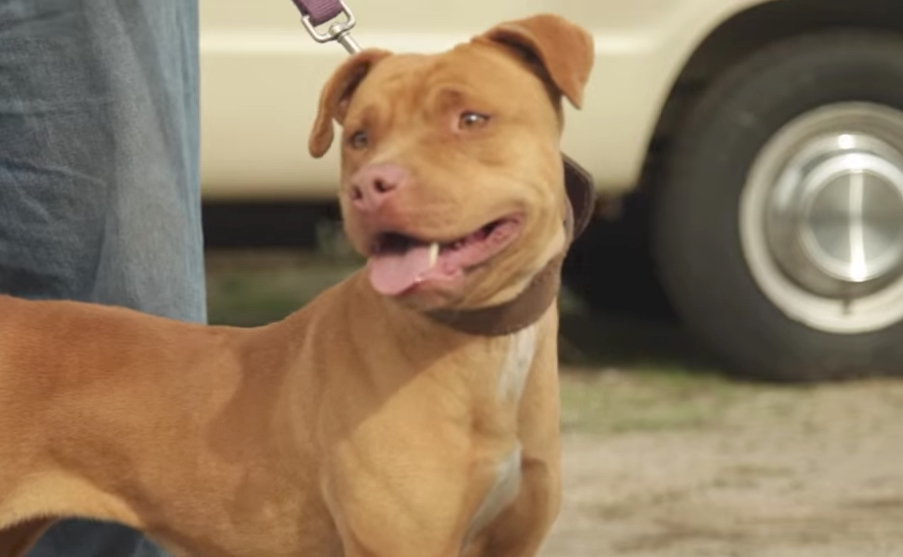Canine News You Can Use
Pit Bulls: Adorable Angels or Deadly Devils? (Part 3: If Looks Could Kill)

It’s easy to identify a Pit Bull, right?
I covered a lot of ground in Part 2, with the main takeaway being that the term, “Pit Bull” really refers to the American Pit Bull Terrier (APBT), a dog bred for fighting. However, it is very common in the media or when you are just conversing amongst your friends that a dog with a certain “look” is a “Pit Bull.” Four of the five dogs in the photo array above are dogs I have trained. One is a dog that we almost adopted (she was the 1st runner-up to Fiona). Would they be labeled as “Pit Bulls” by the way they look? Would you label them as “Pit Bulls” by the way they look? Are any of these dogs American Pit Bull Terriers? I think not. Can they bite? Yes, all dogs can. Do they have the innate characteristics of an American Pit Bull Terrier, such as gameness, tenacity, and tolerance for pain? Again, I think not. Remember when any dog of a mixed breed was known as a “mutt?” That’s what these dogs are, mutts, not American Pit Bull Terriers or true “Pit Bulls.”
Here is another example. One of these photos is of a dog that I trained (62% American Staffordshire Terrier, 12.5% German Shepherd Dog, 12.5% Labrador Retriever, 12.5% Other Mixed Breeds, determined by DNA testing). The other dog is an American Pit Bull Terrier, from a breeder of APBT’s.


Other than seeing the obvious differences in environment, equipment being used, and photo quality, can you really tell which one is the real APBT?
So, when we are trying to sort out the “deadly devils” from the “adorable angels,” would we be able to do it simply by looking at the dog? Breed Specific Legislation (BSL) and the proponents of “they are all devils” would lead you to believe that, of course you can. Here are excerpts of the legislation that bans “Pit Bulls,” from the Tennessee city of South Pittsburg, about 40 miles from us.

As I see it, here are the obvious problems with the legislation:
1) As we have already established, Bull Terriers, Staffordshire Bull Terriers, and the American Staffordshire Terrier are not “Pit Bulls,” and do not have the innate fighting characteristics of the APBT.
2) The identification of a mixed breed dog as a “Pit Bull” (as defined by the legislation) is not very precise, and seems to leave it to the “eye of the beholder.” I posed these questions to the interim Chief of Police for South Pittsburg:
Question #1: Who would make the determination if a mixed breed dog was a pit bull, without owner/keeper/harborer admission of the "50% rule?" Does this person go through training to be able to identify a pit bull, and if so, what is the extent of the training?
Question #2: What does "through identification procedures or otherwise" mean? What are the "identification procedures," and what is "otherwise?"
Question #3: What are the physical characteristics of a pit bull? Is a description available for the person making a determination in #1?
As of this post, I have not received a response – sent on 8/15/2017 and 1 follow up to the original request on 8/29/2017. I will update the blog if I receive a response, and I would guess that any of the dogs in my photo array would be banned from South Pittsburg.
There are also studies that have been done to determine the accuracy with which dog professionals could identify the breed of a dog. The Syracuse Law review published a paper by Katie Barnett in 2017, “The Post-Conviction Remedy for Pit Bulls: What Today’s Science Tells Us About Breed-Specific Legislation.” In it, she references several studies plus a non-scientific test of six dogs impounded at a shelter that had been identified as Pit Bulls.
2009 Voith Study: “Of those sixteen dogs identified by predominant breed, four dogs were also identified by DNA as having those breeds, making the agreement between subjective visual identification and DNA only twenty-five percent.” (Barnett, Page 289)
2012 University of Florida Study: “Shelter staff identified 55 . . . of the 120 dogs to be pit bull[s] with results showing only thirty-six percent of those dogs actually had twenty-five percent American Staffordshire Terrier or Staffordshire Bull Terrier in their genetic ancestry.” (Barnett, Page 287)
2012 Follow-Up Study: “Respondents correctly identified a prominent breed an average of 27% of the time.” (Barnett, Page 289)
2013 Voith Study: “Although the study did not break down the accuracy of breed identification per profession, the accuracy for those professions whose job it is to assign breed labels to dogs varied from zero percent accuracy for eight of the twenty dogs to only as high as seventy-two percent for the identification of one dog.” (Barnett, Page 290)
2012 Toledo Blade DNA Testing (non-scientific testing of six dogs impounded as Pit Bulls): “Although only six dogs were tested, half of the dogs had no pit breed in the DNA result. The dogs found to have no pit bull breed had Boxer, Scottish Terrier, Chinook, American Bulldog, American Eskimo Dog, and Bullmastiff.” (Barnett, Pages 290-291)
So, what does all this mean? Dogsbite.org (remember them?) will tell you that the high courts state, "a dog owner of ordinary intelligence can determine if he does in fact own a dog commonly known as a pit bull," and they cite several court decisions from 1988, 1989, and 1991. Mars Wisdom Panel began its initial canine genomics project in 1999. Here we have two problems with the visual identification of dogs. First, the studies from the Katie Barnett paper would contradict "a dog owner of ordinary intelligence can determine if he does in fact own a dog commonly known as a pit bull.” The studies used professional people like veterinarians, kennel workers, groomers, etc. who work with dogs on a regular basis, and their accuracy in identifying a Pit Bull was poor. Second, “the high courts have ruled” argument pre-dates canine genetic testing by about 10 years. It seems that if we wanted to really sort out the angels from the devils, the most current science would be used.
Here’s the bottom line for “Part 3: If Looks Could Kill”:
1) The visual identification of a mutt’s heritage is generally very poor, for a regular Joe, regular Jane, or a canine professional. This being the case, many pet dogs that pose no threat to the community are likely to be swept up by Breed Specific Legislation (Barnett appropriately calls it, “Looks Specific Legislation”). Surely there are angels being declared to be devils based on looks alone in these situations.
2) Because of the problem with visual identification, dog owners could certainly have “angels” as part of their family. Is the angel a true Pit Bull? Probably not.
Next time, I will wrap up the blog series and give you my final opinion on whether Pit Bulls are angels or devils, as well as some suggestions related on ownership for these types of dogs in Part 4: Just the Facts, Ma’am
Do you have comments or questions? Let us know on Facebook: Pit Bulls: Adorable Angels or Deadly Devils? (Part 3: If Looks Could Kill)
Automatically get notified of our blog updates and other stuff by signing up here: Subscribe Now (as a special bonus, you will also receive access to the “Wait Command Video” and a downloadable poster)
Breaking Through Barriers, Transforming Lives...
Jeff
